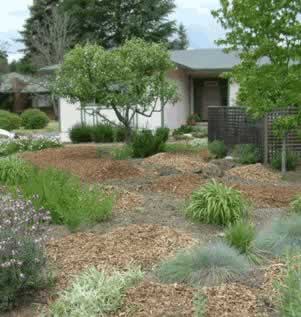- TABLE OF CONTENTS
- REDUCE YOUR WATER NEEDS
- Use Drought Tolerant Plants
- California Native Plants
- Climate Zones
- Reduce or Replace Lawn
- Artificial Turf
- IRRIGATE EFFICIENTLY
- Water Needs of Plants
- Before You Design
- Types of Irrigation Systems
- Weather Based Irrigation Controllers
- Working with an Irrigation Contractor
- DEVELOP ALTERNATE SOURCES OF WATER
- RETAIN WATER IN THE LANDSCAPE
- Build Retaining Walls
- Mulch to Reduce Evaporation
- Install Permeable Hardscapes
- Amend Soil with Organic Materials
- KEEP YOUR WATER PURE
- Drainage
- Eliminate Runoff and Overspray
- Slow it, Spread it, Sink it
- Ocean Friendly Gardens
- Rain Gardens
- Swales
- Keep Your Watershed Beautiful
- Soil
- Pests
- Select Plants that Don't Need Chemicals
- ADDITIONAL GARDENING RESOURCES
Mulch
Mulching is one of the simplest ways to enhance your garden. It insulates the soil, protects it from erosion, conserves moisture, reduces weed growth, reduces soil compaction from heavy rain, provides a beautiful finishing touch to your garden, and may even improve soil quality as it breaks down. Mulching, or top dressing, refers to covering the bare ground in your garden by spreading an organic or inorganic material such as rock over the surface of the soil. Many materials have been tried and proven effective as mulches: chipped or shredded bark, leaves, sawdust, straw, processed by-products (grape and apple pumice), and lawn clippings.
Compost is organic matter made of decomposed plant material and/or manure. Compost is generally a soil amendment and usually incorporated into the soil. Mulch is used as a top dressing after plants and irrigation have been installed. Mulch may cover drip irrigation.
Mulch Benefits
-
Moderates the soil temperature and retains moisture during dry weather, reducing the amount of water used in the landscape and lost to evaporation.
-
Prevents germination of many weed seeds and reduces need for herbicides.
-
May add organic matter to soil as it decomposes.
-
Encourages the activity of worms and other beneficial soil organisms.
Mulch also can be used to enhance the look of your garden.
-
Mulch helps keep plants clean by reducing the splash of soil onto leaves during rainstorms, protecting soil to prevent surface crusting and improving infiltration of water into the garden.
 |
-
Purchase organic mulches that are guaranteed to be weed-free. Straw, hay, and many types of manure, for instance, may contain weed seeds.
Remove weeds before spreading mulch.
To protect plants from insects and rot, which thrive in moist conditions, keep organic mulches a few inches back from the crowns and trunks of woody plants, like trees and native plants.
-
When reapplying mulch, wait until the soil is completely warm before spreading.
-
On steep slopes where terracing is not practical, mulch areas with coarse-grade or shredded bark, which is heavy enough not to be easily blown or washed off by rain.
-
Under existing native oak trees, use mulch to cover the bare soil and do not plant anything.
Do not spread mulch over plastic, as plastic is an impermeable layer and will prevent any soil improvement from the mulch.
Lay mulch 2-3 inches thick.
Chop leaves with lawnmower before spreading no more than 2 inches thick.
-
Lawn clippings can be mixed with other garden and vegetable waste to produce compost, which then can be used as mulch or mixed into the soil as amendment.
-
Sheet Mulching: Cardboard/Newspaper can be used along with mulch. Cover the soil with cardboard and/or newspapers 4-6 sheets thick, overlapping edges by 6". If using cardboard, one layer may be sufficient. Wet down with a hose and cover with mulch. This method is especially good for weed control. Newspapers do not contain weed seeds. If you want to plant within the area of the newspaper mulch, cut an "X" through the newspaper, fold it back, loosen the soil with a trowel, and plant. Fold the newspaper back, making sure the mulch is clear of the plant’s stem to avoid rot.
-
For information about mulch, visit www.riverfriendly.org and read "A River-Friendly Landscaping Guide to Mulch and Grasscycling".
Mulch Myths
Myth No. 1: Mulch provides a permanent barrier to weeds. While mulch reduces weed growth, some may still manage to grow through the mulch, or on top of it. Weeds will appear in new landscapes for the first year or two, even with mulch, due to the abundance of weed seeds in the soil. However, once the weeds are brought under control, fewer will appear. Organic mulch needs to be replenished when it decomposes to less than 1 inch thick. The thicker the mulch the easier it is to pull weeds that do come up.
Myth No. 2: Mulch placed against your house will attract termites. In reality, it’s moisture, not mulch, which attracts termites. So any landscaping, including shrubs, can lure the unwanted critters. Irrigation systems up against the house also create a termite-conducive environment. Even gravel or rocks around the base of a house can hold in moisture which is attractive to termites.
Myth No. 3: There’s no wrong way to mulch. When mulching, keep the bark or rock one to two inches away from plant crowns. Mulch creates a warm and humid environment that is perfect for the establishment of various fungi that can injure or kill plants. Also, avoid covering the crown of dormant perennials.
How Much Mulch?
Determine the square feet of the area you want to cover by multiplying the length of your garden by the width.
Now multiply the size of your garden in square feet by 2 (the depth of your mulch in inches).
Divide this sum by 324. The result is the number of cubic yards of mulch you will need to cover your garden.
For more information:
About soil fertility and mulch:
UCSC Center for Agroecology & Sustainable Food Systems:
http://casfs.ucsc.edu/publications/gardenideas/soilfert.html
Places where you can find mulch locally:
Santa Cruz County Dept. of Public Works:
http://dpw.co.santa-cruz.ca.us/Home/RecyclingSolidWaste/Composting/CompostandMulch.aspx